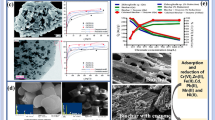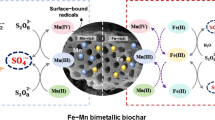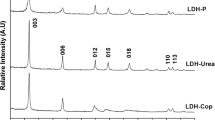Abstract
Adsorption of uranyl (UO22+) ions to mineral surfaces is a potentially effective method for removing this hazardous metal from water, but other toxic trace metal ions (Xn+: Rb+, Sr2+, Cr3+, Mn2+, Ni2+, Zn2+, Cd2+) in uraniferous wastewaters compete with UO22+ for adsorption sites and thus may diminish the capacity of adsorbents to sequester UO22+. A better understanding of competitive adsorption among these metal ions and the development of better adsorbents are, therefore, of critical importance. The purpose of the present study was to synthesize and characterize magnetic adsorbents, consisting of MFe2O4 (M = Mn, Fe, Zn, Co, or Ni) nanoparticles synthesized on montmorillonite (Mnt) edge sites, and to investigate their use as adsorbents for UO22+, including competitive adsorption with trace metal ions. Selective adsorption was studied using Langmuir, Freundlich, and Dubinin-Radushkevich isotherms, and the results showed that Xn+ ions were adsorbed primarily on MFe2O4-montmorillonite surfaces, and the UO22+ ions were adsorbed on the interfaces between montmorillonite edge surfaces and MFe2O4 nanoparticles. Using the Freundlich model, the interface adsorption capacity of UO22+ reached 25.1 mg·g–1 in mixed solution. Further, the UO22+ and Cr3+ ions had a redox reaction on the interfaces with synergistic adsorption. Herein, the adsorption capacity of Cr3+ was 60.2 mg·g–1 using the Freundlich isotherm. The results demonstrated that the MFe2O4-montmorillonite with highly selective adsorption of UO22+ ions is applicable to UO22+ treatment in the presence of toxic trace metal ions.

.













Similar content being viewed by others
References
Ai, Y. J., Liu, Y., Lan, W. Y., Jin, J. R., Xing, J. L., & Zou, Y. D. (2018). The effect of pH on the U(VI) sorption on graphene oxide (GO): A Theoretical Study. Chemical Engineering Journal,343, 460–466.
Bedelean, H., Măicăneanu, A., Burcă, S., & Stanca, M. (2009). Removal of heavy metal ions from wastewaters using natural clays. Clay Minerals,44, 487–495.
Bhattacharyya, K. G., & Gupta, S. S. (2008). Adsorption of a few heavy metals on natural and modified kaolinite and montmorillonite: A review. Advances in Colloid and Interface Science,140, 114–131.
Bian, L., Li, H. L., Li, Y. J., Nie, J. N., Dong, F. Q., Dong, H. L., Bian, L., Li, H., & Li, Y. (2017). Enhanced photovoltage response of hematite-X-ferrite interfaces (X = Cr, Mn, Co, or Ni). Nanoscale Research Letters,12, 136.
Bian, L., Song, M., Dong, F., Duan, T., Xu, J., & Li, W. (2015). DFT and two-dimensional correlation analysis for evaluating the oxygen defect mechanism of low-density 4f (or 5f) elements interacting with Ca-Mt. RSC Advances,5, 28601–28610.
Brigatti, M. F., Galán, E., & Theng, B. K. G. (2013). Structures and mineralogy of clay minerals. Pp. 19–86 in: Developments in Clay Science (F. Bergaya, B.K.G. Theng and G. Lagaly, editors). Elsevier, Amsterdam 1, 19–86.
Burns, P. C., Ewing, R. C., & Navrotsky, A. (2012). Nuclear fuel in a reactor accident. Science,335, 1184–1188.
Campos, B., Aguilar-Carrillo, J., Algarra, M., Gonçalves, M. A., Rodríguez-Castellón, E., & Silva, J. C. (2013). Adsorption of uranyl ions on kaolinite, montmorillonite, humic acid and composite clay material. Applied Clay Science,85, 53–63.
Chang, J., Ma, J., Ma, Q., Zhang, D., Qiao, N., & Hu, M. (2015). Adsorption of methylene blue onto Fe3O4/activated montmorillonite nanocomposite. Applied Clay Science,119, 132–140.
Chen, J., Wen, W., Kong, L., Tian, S., Ding, F., & Xiong, Y. (2014). Magnetically separable and durable MnFe2O4 for efficient catalytic ozonation of organic pollutants. Industrial & Engineering Chemistry Research,53, 6297–6306.
Chen, H., Wang, Y., Zhao, W., Xiong, G., Cao, X., & Dai, Y. (2017). Phosphorylation of graphehe oxide to improve adsorption of U(VI) from aqueous solutions. Journal of Radioanalytical & Nuclear Chemistry,313, 1–15.
Chen, L., Zhou, C. H., & Fiore, S. (2016). Functional magnetic nanoparticle/clay mineral nanocomposites: Preparation, magnetism and versatile applications. Applied Clay Science,127–128, 143–163.
Choi, J., & Park, J. W. (2005). Competitive adsorption of heavy metals and uranium on soil constituents and microorganism. Geosciences Journal,9, 53–61.
De, D.J., Folens, K., De, C.J, Meledina, M., Van, T.G., Du, L.G. and Van, D.V.P., (2017) Ship-in-a-bottle CMPO in MIL-101(Cr) for selective uranium recovery from aqueous streams through adsorption. Journal of Hazardous Materials, 335, 1–9.
Debasish, D., Sureshkumar, M. K., Siddhartha, K., Mithal, N., & Pillai, C. G. S. (2010). Sorption of uranium on magnetite nanoparticles. Journal of Radioanalytical and Nuclear Chemistry,285, 447–454.
Deng, J., Chen, Y., Lu, Y., Ma, X., Feng, S., Gao, N., & Li, J. (2017). Synthesis of magnetic CoFe2O4/ordered mesoporous carbon nanocomposites and application in fenton-like oxidation of rhodamine B. Environmental Science and Pollution Research,24, 14396–14408.
Dhiraj, S., Garima, M., & Kaur, M. P. (2008). Agricultural waste material as potential adsorbent for sequestering heavy metal ions from aqueous solutions – A review. Bioresource Technology,99, 6017–6027.
Dorota, K., Marzena, G., Ievgen, V. P., & Hubicki, Z. B. (2016). Development of new effective sorbents based on nanomagnetite. Nanoscale Research Letters,11, 152.
Dubinin, M. M. (1960). The Potential Theory of adsorption of gases and vapors for adsorbents with energetically nonuniform surfaces. Chemical Reviews,60, 235–241.
Fatimah, I., Wang, S., & Wulandari, D. (2011). ZnO/montmorillonite for photocatalytic and photochemical degradation of methylene blue. Applied Clay Science,53, 553–560.
Freundlich, H. (1906). Ueber die adsorption in loesungen (Adsorption in solution). Physical Chemistry,57, 384–470.
Gao, X., Liu, X., Zhu, Z., Wang, X., & Xie, Z. (2016). Enhanced photoelectrochemical and photocatalytic behaviors of MFe2O4 (M = Ni, Co, Zn and Sr) modified TiO2 nanorod arrays. Scientific Reports,6, 30543–30558.
Hajjaji, W., Andrejkovicova, S., Pullar, R. C., Tobaldi, D. M., Lopez-Galindo, A., Jammousi, F., Rocha, F., & Labrincha, J. A. (2016). Effective removal of anionic and cationic dyes by kaolinite and TiO2/kaolinite composites. Clay Minerals,51, 19–27.
He, H., Zong, M., Dong, F., Yang, P., Ke, G., & Liu, M. (2017). Simultaneous removal and recovery of uranium from aqueous solution using TiO2, photoelectrochemical reduction method. Journal of Radioanalytical & Nuclear Chemistry,313, 59–67.
Hennig, C., Reich, T., Dahn, R., & Scheidegger, A. M. (2002). Structure of uranium sorption complexes at montmorillonite edge sites. Radiochimica Acta, 90, 653–657.
Hong, H., Kim, J., Fang, X., Hong, S., & Chiang, T. C. (2017). Interfacial stability of ultrathin films of magnetite Fe3O4(111) on Al2O3(001) grown by ozone-assisted molecular-beam epitaxy. Applied Physics Letters,110, 021601.
Hu, B., Ye, F., & Ren, X. (2016). X-ray absorption fine structure study of enhanced sequestration of U(VI) and Se(IV) by montmorillonite decorated zerovalent iron nanoparticles. Environmental Science: Nano,3, 1460–1472.
Hu, J., Lo, I. M., & Chen, G. (2005). Fast removal and recovery of Cr(VI) using surface-modified jacobsite (MnFe2O4) nanoparticles. Langmuir the ACS Journal of Surfaces & Colloids,21, 11173–11179.
Hu, C., Gao, Z., & Yang, X. (2008). One-pot low temperature synthesis of MFe2O4 (M = Co, Ni, Zn) superparamagnetic nanocrystals. Journal of Magnetism & Magnetic Materials,320, L70–L73.
Jiang, H., Sun, M., Xu, J., Lu, A., & Shi, Y. (2016). Magnetic Fe3O4 Nanoparticles modified with polyethyleneimine for the removal of Pb(II). Clean Soil Air Water,44, 1146–1153.
Kalantari, K., Ahmad, M.B., Masoumi, H.R, Shameli, K., Basri, M. and Khandanlou, R. (2015) Rapid and high capacity adsorption of heavy metals by Fe3O4/montmorillonite nanocomposite using response surface methodology: preparation, characterization, optimization, equilibrium isotherms, and adsorption kinetics study. Journal of the Taiwan Institute of Chemical Engineers, 49, 192–198.
Karamanis, D. T. (1997). An aluminum pillared montmorillonite with fast uptake of strontium and cesium from aqueous solutions. Clays and Clay Minerals,45, 709–717.
Langmuir, I. (1918). The adsorption of gases on plane surfaces of glass, mica and platinum. Journal of the American Chemical Society,40, 1361–1368.
Li, Y., Yi, H., Tang, X., Liu, X., Wang, Y., & Cui, B. (2016). Study on the performance of simultaneous desulfurization and denitrification of Fe3O4-TiO2 composites. Chemical Engineering Journal,304, 89–97.
Li, Y.Z, Wu, S.X., Yu, X.L., Bao, R.M., Wu, Z.K. & Wang, W. (2017) Optimization of pyrolysis efficiency based on optical property of semicoke in terahertz region. Energy, 126, 202–207.
Liu, G., Fang, H., Jing, Z., Li, L., Li, F., & Chen, L. (2014a). Yolk–shell structured Fe3O4@C@F-TiO2, microspheres with surface fluorinated as recyclable visible-light driven photocatalysts. Applied Catalysis B Environmental,150-151, 515–522.
Liu, S., Xie, J., Su, Q., Du, G., Zhang, S., & Cao, G. (2014b). Understanding Li-storage mechanism and performance of MnFe2O4, by in situ TEM observation on its electrochemical process in nano lithium battery. Nano Energy,8, 84–94.
Liu, M., Yang, L., & Zhang, L. (2016). Functionalization of magnetic hollow porous oval shape NiFe2O4 as a highly selective sorbent for the simultaneous determination of five heavy metals in real samples. Talanta,161, 288–296.
Lu, A. H., Salabas, E. L., & Schüth, F. (2010). Magnetic nanoparticles: synthesis, protection, functionalization, and application. Angewandte Chemie,46, 1222–1244.
McKinley, J. P., Zachara, J. M., Smith, S. C., & Turner, G. D. (1995). The influence of uranyl hydrolysis and multiple site-binding reactions on adsorption of U(VI) to montmorillonite. Clays and Clay Minerals,43, 586–598.
Min, H. B, & Lee, S. Y. (2010). Colloidal stability of bentonite clay considering surface charge properties as a function of pH and ionic strength. Journal of Industrial & Engineering Chemistry,16, 837–841.
Phumying, S., Labuayai, S., Swatsitang, E., Amornkitbamrung, V., & Maensiri, S. (2013). Nanocrystalline spinel ferrite (MFe2O4, M = Ni, Co, Mn, Mg, Zn) powders prepared by a simple aloe vera plant-extracted solution hydrothermal route. Materials Research Bulletin,48, 2060–2065.
Pylypchuk, I. V., Kołodyńska, D., Kozioł, M., & Gorbyk, P. P. (2016). Gd-DTPA adsorption on chitosan/magnetite nanocomposites. Nanoscale Research Letters,11, 168.
Qiu, W., Yang, D., Xu, J., Hong, B., Jin, H., & Jin, D. (2016). Efficient removal of Cr(VI) by magnetically separable CoFe2O4/activated carbon composite. Journal of Alloys and Compounds,678, 179–184.
Rekhila, G., Trari, M., & Bessekhouad, Y. (2017). Characterization and application of the hetero-junction ZnFe2O4/TiO2 for Cr(VI) reduction under visible light. Applied Water Science,7, 1273–1281.
Rufyikiri, G., Wannijn, J., Wang, L., & Thiry, Y. (2006). Effects of phosphorus fertilization on the availability and uptake of uranium and nutrients by plants grown on soil derived from uranium mining debris. Environmental Pollution,141, 420–427.
Sadeghi, S., Azhdari, H., Arabi, H., & Moghaddam, A. Z. (2012). Surface modified magnetic Fe3O4 nanoparticles as a selective sorbent for solid phase extraction of uranyl ions from water samples. Journal of Hazardous Materials,215-216, 208–216.
Santos, A. C., Barbosa, S., Pessoa, M. F., Leal, N., & Reboredo, F. (2018). Speciation, mobility and adsorption effects of various metals in sediments in an agricultural area surrounding a uranium ore deposit (Nisa, Portugal). Emirates Journal of Food and Agriculture,30, 503–514.
Singer, D. M., Chatman, S. M., Ilton, E. S., Rosso, K. M., Banfield, J. F., & Waychunas, G. A. (2012). Identification of simultaneous U(VI) sorption complexes and U(IV) nanoprecipitates on the magnetite (111) surface. Environmental Science & Technology,46, 33811–33820.
Singhal, P., Jha, S. K., Pandey, S. P., & Neogy, S. (2017). Rapid extraction of uranium from sea water using Fe3O4 and humic acid coated Fe3O4 nanoparticles. Journal of Hazardous Materials,335, 152–161.
Soliman, A. M., Murad, A. A., Sheikh, E. S. E., Massad, A. M., & Ali, I. M. (2017). Selective removal of uranium from wastewater using sludge collected from refinery wastewater treatment: Equilibrium, thermodynamic and kinetics studies. Journal of Water Process Engineering,19, 267–276.
Sun, S., Zeng, H., Robinson, D. B., Raoux, S., Rice, P. M., Wang, S. X., & Li, G. (2004). Monodisperse MFe2O4 (M = Fe, Co, Mn) nanoparticles. Journal of the American Chemical Society,126, 273–279.
Tinas, H., Çalişkan, E., Özbek, N., & Akman, S. (2016). Preparation of Fe3O4@ montmorillonite composite as an effective sorbent for the removal of lead and cadmium from wastewater samples. Turkish Journal of Chemistry,40, 974–978.
Todorov, P. T., & Ilieva, E. N. (2006). Contamination with uranium from natural and anthropological sources. Romanian Journal of Physics,51, 27–40.
Tu, Y., Chan, T., Tu, H., Wang, S., You, C., & Chang, C. (2016). Rapid and efficient removal/recovery of molybdenum onto ZnFe2O4 nanoparticles. Chemosphere,148, 452–458.
Villalobos, M., Trotz, M. A., & Leckie, O. J. (2001). Surface complexation modeling of carbonate effects on the adsorption of Cr(VI), Pb(II), and U(VI) on goethite. Environmental Science & Technology,35, 3849–3856.
Wang, L., Li, J., Wang, Y., Zhao, L., & Jiang, Q. (2012a). Adsorption capability for congo red on nanocrystalline MFe2O4, (M = Mn, Fe, Co, Ni) spinel ferrites. Chemical Engineering Journal,181-182, 72–79.
Wang, L., Li, J., Jiang, Q., & Zhao, L. (2012b). Water-soluble Fe3O4 nanoparticles with high solubility for removal of heavy-metal ions from waste water. Dalton Transactions,41, 4544–4552.
Wilke, I., Ramanathan, V., Lachance, J., Tamalonis, A., Aldersley, M., & Joshi, P. C. (2014). Characterization of the terahertz frequency optical constants of montmorillonite. Applied Clay Science,87, 61–65.
Xiao, J., Chen, Y., & Xu, J. (2014). Plasma grafting montmorillonite/iron oxide composite with β-cyclodextrin and its application for high-efficient decontamination of U(VI). Journal of Industrial and Engineering Chemistry,20, 2830–2839.
Xuan, S., Zeng, S., Fan, M., Qin, L., & Shu, K. (2010). One-step method of fabricating Fe3O4/Montmorillonite magnetic nanocomposites. Rare Metal Materials & Engineering,39, 165–168.
Xu, S., Zhang, Y., Wang, S., Xu, J., Ding, H., & Li, G. (2013). Structure-enhanced photocatalytic removal of Cr(VI) by a TiO2 superstructure with ultrathin rutile nanorods and abundant {110}faces. European Journal of Inorganic Chemistry,14, 2601–2607.
Yan, L., Li, S., Yu, H., Shan, R., Du, B., & Liu, T. (2016). Facile solvothermal synthesis of Fe3O4/bentonite for efficient removal of heavy metals from aqueous solution. Powder Technology,301, 632–640.
Yu, X., Huo, C. F., Li, Y. W., Wang, J., & Jiao, H. (2012). Fe3O4 surface electronic structures and stability from GGA+U. Surface Science,606, 872–879.
Zhang, X., Wang, J., Li, R., Dai, Q., & Liu, L. (2013). Removal of uranium(VI) from aqueous solutions by surface modified magnetic Fe3O4 particles. New Journal of Chemistry,37, 3914–3919.
Zhou, C. H., & Keeling, J. (2013). Fundamental and applied research on clay minerals: From climate and environment to nanotechnology. Applied Clay Science,74, 3–9.
Zhou, C. H., Zhao, L. Z., Chen, T. H., Ai, Q. W., & Hong, P. H. (2016). Current fundamental and applied research into clay minerals in China. Applied Clay Science,119, 3–7.
Zhu, R., Chen, Q., Zhou, Q., Xi, Y., Zhu, J., & He, H. (2016). Adsorbents based on montmorillonite for contaminant removal from water: A review. Applied Clay Science,123, 239–258.
Zou, H., Song, M., Yi, F., Bian, L., Liu, P., & Zhang, S. (2016). Simulated-sunlight-activated photocatalysis of methyl orange using carbon and lanthanum co-doped Bi2O3-TiO2 composite. Journal of Alloys and Compounds,680, 54–59.
Zuo, Q., Gao, X., Yang, J., Zhang, P., Chen, G., Li, Y., Shi, K., & Wu, W. (2017). Investigation on the thermal activation of montmorillonite and its application for the removal of U(VI) in aqueous solution. Journal of the Taiwan Institute of Chemical Engineers,80, 754–760.
Acknowledgments
The authors acknowledge funding from the National Natural Science Foundation of China (41872039 and 41831285), the One-Thousand Talents Scheme in Sichuan Province, Sichuan Science and Technology Program (2018JY0462), and Longshan Fund of Southwest University of Science and Technology (17QR004).
Author information
Authors and Affiliations
Corresponding authors
Additional information
This paper was originally presented during the World Forum on Industrial Minerals, held in Qing Yang, China, October 2018
Electronic supplementary material
ESM 1
(DOC 1980 kb)
Rights and permissions
About this article
Cite this article
Jiang, X., Nie, J., Bian, L. et al. Competitive Adsorption of Uranyl and Toxic Trace Metal Ions at MFe2O4-montmorillonite (M = Mn, Fe, Zn, Co, or Ni) Interfaces. Clays Clay Miner. 67, 291–305 (2019). https://doi.org/10.1007/s42860-019-00028-x
Received:
Revised:
Published:
Issue Date:
DOI: https://doi.org/10.1007/s42860-019-00028-x




